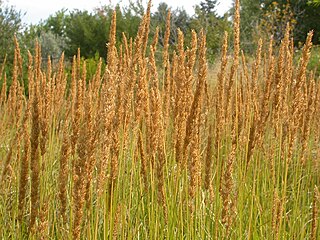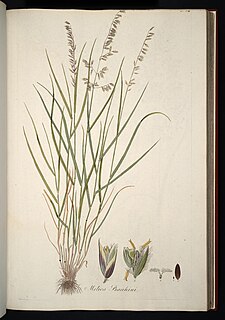
Calamagrostis stricta, known as slim-stem small reed grass or narrow small-reed, is a species of bunchgrass in the family Poaceae of the Holarctic Kingdom.
Melica argyrea is a species of grass found in Argentina, Brazil, and Uruguay.

Melica amethystina is a grass species in the family Poaceae that can be found in southern Europe.
Melica animarum is a species of grass that is endemic to Sierra de las Ánimas in Uruguay.
Melica longiflora is a grass species in the family Poaceae that is endemic to Chile where it can be found from Coquimbo to Talca.
Melica bonariensis is a species of grass endemic to Argentina where it can be found in such provinces as Buenos Aires, La Pampa, and Rio Negro.
Melica brasiliana, is a grass species in the family Poaceae that is endemic to Brazil and southern South America.
Melica tenuis, is a species of grass that can be found in Brazil, Paraguay, Uruguay and Argentinian provinces such as Misioines and Entre Rios.
Melica spartinoides, is a species of grass endemic to Santa Catarina, Brazil.
Melica serrana, is a species of grass endemic to Cerro de las Ánimas, Uruguay.
Melica stuckertii, is a grass species in the family Poaceae that is endemic to Argentina and southern South America.
Melica dendroides is a grass species in the family Poaceae that is endemic to southern part of Africa.
Melica commersonii is a species of grass endemic to Chile.
Melica hyalina is a species of grass found in Brazil and southern South America.
Melica decipiens is a species of grass that can be found in the mountains of Cordoba and San Luis provinces of Argentina.
Melica lilloi is a species of grass found in Catamarca and Tucumán provinces of Argentina at 3,200–3,500 metres (10,500–11,500 ft) above sea level.
Melica paulsenii is a species of grass endemic to Chile where it grows along the coastal cordillera at 50–700 metres (160–2,300 ft) above sea level.
Melica rigida is a species of grass found in Argentina, Brazil, and Uruguay.
Melica patagonica is a species of grass that is endemic to South America.
Melica parodiana is a species of grass found in Buenos Aires, Argentina and Uruguay.

